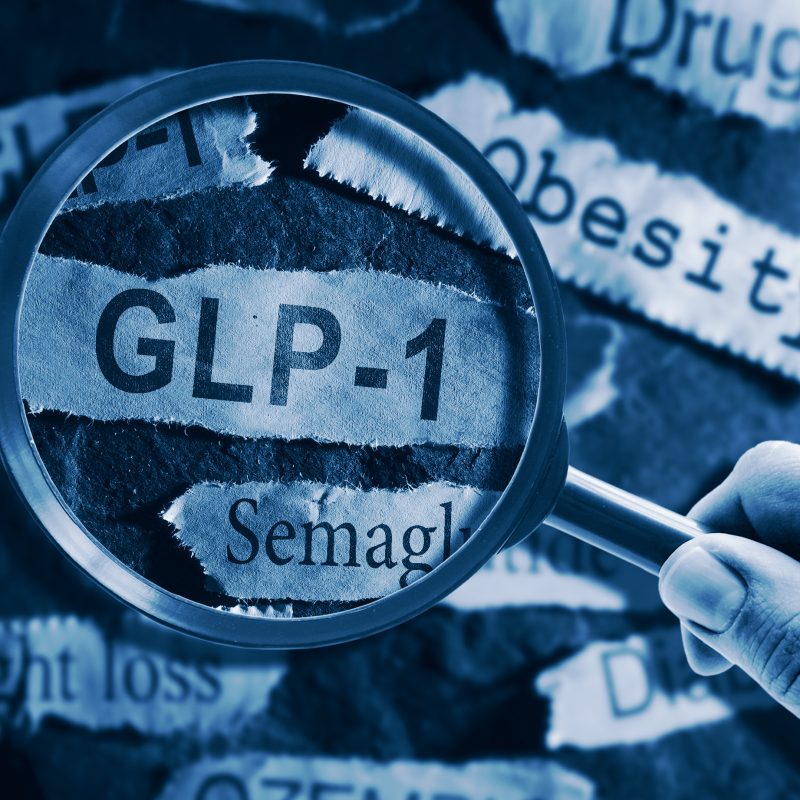
The prevalence of diabetes, rising worldwide, affects an estimated 463 million people. Type 2 diabetes accounts for approximately 95% of all cases, and remains challenging to manage despite the variety of available treatment options. While current guidelines recommend a lifestyle-based approach to treatment, many patients still seek to co-manage their conditions through the addition of prescription medications. The glucagon-like peptide 1 receptor agonists (GLP-1 RA) purport to effectively bring down A1C levels and weight while having a low risk of hypoglycemia. This class of drugs witnessed a growth spurt in the last decade. Here we present a thorough discussion of some of the more commonly prescribed GLP-1 treatments, including an assessment of similarities, differences, advantages and side effects.
The Pharmacology of GLP-1
This fairly new class of weight-loss drugs has garnered tremendous media attention and witnessed a meteoric rise in popularity over the past 10 years. The FDA approved the first GLP-1 medication in 2005. The oral Ozempic tablet was approved by the FDA in 2019; all the other drugs get administered via subcutaneous injections.
In order to fully grasp the power of its efficacy, both in controlling diabetes and managing obesity, we first need to gain an understanding of how this naturally-occurring GLP-1 hormone functions within the human body.
Originating in the small intestine, GLP-1 serves many important roles:
- Signals the pancreas to release insulin, a hormone that controls blood glucose levels in response to utilizing food for fuel
- Blocks the secretion of glucagon, a hormone which raises blood sugars when needed
- Slows stomach emptying/digestion, thereby releasing less food-derived glucose into the bloodstream
- Increases feeling of satiety
The GLP-1 receptor agonist medications work by attaching to a cell receptor and mimicking the actions of this naturally-occurring hormone. We often see television commercials advertising these products, which appear under various names: Trulicity, Ozempic, Victoza and Rybelsus, among others. As we might expect, the higher the dose of medication, the more extreme the body perceives its effects.
Risk versus Benefit of Weight-Loss Drugs
While all GLP-1 drugs bear some commonality, some do offer key differences in administration, efficacy and, most importantly, potential side effects. The majority of GLP-1s have a dosage prescription of either 1x/day or 1x/week. Some of these drugs work well at any time of day, whereas some perform optimally when taken an hour before a meal.
For the most part, the more commonly-prescribed GLP-1 medications share the following advantages:
- Decreasing blood pressure
- Improvements in lipid disorders/fatty liver disease
- Delays the progression of diabetes-related nephropathy
- Reducing risks of both heart disease and kidney disease
- Weight loss
As with any medication, over-the-counter or prescription, taking into consideration all potential side effects can help patients make a more informed decision.
The most often-reported side effects from GLP-1 drugs include:
- Significant loss of appetite
- Gastrointestinal disruptions: diarrhea, indigestion, nausea and vomiting
- Dizziness
- Headaches
- Mild heart rate elevation (tachycardia)
- Irritation at injection site
A prudent medical professional will likely feel the need to share some possible side effects that do occur in extreme cases:
- Attacks of pancreatitis
- Acute onset of kidney damage
- Medullary thyroid cancer
- Exacerbation of pre-existing diabetic retinopathy
After the Selection, Is Switching Medications a Good Idea?
Differences between GLP‐1RAs in dosing regimens and clinical effects, including cardiovascular (often a co-morbidity in patients dealing with obesity and/or type 2 diabetes), sometimes lead patients and their practitioners to switch medications. While benefits may exist, clinical data on this process and its long-term outcomes still remains limited.
After trying a GLP-1 medication for a period of time, many patients still present with significant symptoms despite regular adherence. Physicians may encourage their patients to switch to another prescription formula if they desire additional weight loss, have failed to lower their A1C levels, or other co-morbidity concerns have caused an uptick in their cardiovascular health risk. Sometimes a change stems from insurance coverage or cost issues. Regardless of the reason, the decision to change medications mid-treatment should result from a joint approach between a patient and his entire medical team.
Cardiovascular Considerations
Subcutaneous Ozempic received FDA approval as a drug to reduce the risk of major cardiovascular adverse events in patients with type 2 diabetes and established cardiovascular disease. Trulicity received approval for improving HbA1c in patients with an increased risk of cardiovascular events. The proven efficacy of Ozempic at a dosage of 2.4 mg once-weekly injection led the FDA to also approve it for chronic weight management as of 2021. The other GLP-1 analogs also boast weight loss as a side effect of regular use, although, except for high-dose Victoza and Ozempic, they have not been FDA-approved for this indication.
Weight Loss and Decreasing A1C
Many clinical studies have compared and contrasted the short-acting and long-acting GLP-1 drugs in an attempt to gauge their efficacy and safety. One analysis showed that once-weekly GLP-1 analogs performed better at reducing A1C levels while performing equally well in terms of weight loss than other non- GLP medications, but not better than the Victoza once-daily injection.
In general terms, it appears that the use of long-acting GLP-1 analogs result in greater A1C lowering than the short-acting agents. Patient satisfaction results indicate that once weekly injections naturally rank higher than those requiring twice daily injections. Comparing just the once weekly agents, patient satisfaction appears highest for Trulicity, a single-use, disposable pen injection device.
Keeping an Eye on Progress
Like other medications commonly prescribed for type 2 diabetes, medical professionals should guide their patients toward A1C checks every 3 months; this helps provide a reliable value for glycemic control. In terms of blood glucose levels, patients typically choose either to get tested regularly or wear a continuous glucose monitoring device. In addition, due to the heightened risk of renal complications associated with type 2 diabetes, pharmaceutical companies as well as physicians stress the importance of regular renal function testing.
Since medicating with Ozempic may carry the risk of retinopathy associated with rapid glucose reduction, patients must also undergo yearly comprehensive eye exams.
Encouraging a Natural Boost of GLP-1
Despite the popularity of drugs like Ozempic and other GLP-1 analogs for weight loss, a majority of individuals still seem to gravitate towards a drug-free approach to weight loss. Nutritional studies lead us to believe that careful attention to certain dietary strategies can help naturally mimic the effects of these pharmaceutical products. These strategies include food choices, optimal time(s) of the day for consumption, variations in mastication (chewing), and even the speed with which we consume our meals.
Increased intakes of both fiber and the monounsaturated fats found in olive oil and avocados can naturally stimulate production of the same hormone responsible for the effects of many commercially available GLP-1 drugs. Eating a protein source or vegetable prior to a carbohydrate source tends to result in higher blood levels of GLP-1. Similarly, the timing of nutrient intake plays a role, as it does with all hormones. A healthy and hearty 8:00 AM breakfast stimulates more of a GLP-1 release than a small dinner eaten at 6:30 PM.
Chewing and the Speed of Eating
One interesting piece of data tells us that leisurely enjoying a dish of ice cream over the course of a half-hour can elicit a higher GLP-1 level than gobbling up the same serving of ice cream in just 5 minutes. Even chewing versus drinking seems to make a difference. One study confirmed the hypothesis that eating a serving of shredded cabbage can raise one’s GLP-1 level significantly over an identical serving of pureed cabbage.
Below we list various food choices that can provide a natural GLP-1 boost to the body ~
- Sources of soluble fiber: fruits, vegetables, legumes, flaxseeds/chia seeds
- Protein sources: lean meats, eggs, nuts, beans, lentils
- Sources of healthy fats: avocados, nuts, olive oil
- Whole grains: oats, barley, quinoa
- Leafy greens: spinach and kale
The Downside of Weight Loss
For individuals dealing with obesity-related health issues, GLP-1 medications can serve a life-saving role. However, in the absence of a comprehensive treatment plan including balanced nutrition, physical activity, and strategies to preserve/increase skeletal muscle mass, patients run the risk of losing much more than just adipose tissue.
A key hallmark of all drugs in the GLP-1 class lies in its extreme appetite suppression. In the absence of a certain minimal caloric level, the body must pull energy from sources other than nutrient-based fuel. If a patient does not engage in regular resistance training as an adjunct to his drug regimen, the body will out of necessity begin to tap into lean muscle mass and the bone matrix/skeletal muscle to find alternative energy sources. This in turn places an additional burden on one’s strength, mobility and metabolism. At some point, patients may request a discussion with their medical providers regarding what really defines weight loss success.
Weight loss involves more than merely the number on the scale. According to recent research in The Lancet, up to 39% of the weight loss experienced by patients on GLP-1 analog drugs can come from lean muscle mass. When weight loss reaches a significant level, muscle mass and bone integrity tend to diminish as well. Weight loss induced by lower caloric intake almost always results in muscle loss and lower fat levels within the muscle tissue. Besides facilitating movement, muscles help absorb glucose in response to the insulin secreted after a meal.
The impaired glucose uptake, or reduced sensitivity of muscles to insulin in obesity, results in an increased breakdown of muscle protein and muscle loss. In contrast, safe weight loss improves muscle insulin sensitivity which actually helps prevent muscle protein breakdown. Thus, the concern with GLP-1 drugs rests upon whether these medications induce excessive muscle loss for the achieved decline in weight.
A New Face in the Mirror
In addition to the aforementioned potential consequences of sudden-onset weight loss, significant changes to one’s visage also accompany rapid fat loss. Individuals often observe the following:
- Haggard, hollowed-out appearance to the face
- Eyes appear sunken in their sockets
- Sagging skin around the neck and jawline
- Alterations in the size of chin, cheeks and lips
- Appearance of additional wrinkles
When these manifestations reach serious proportions, some individuals actually choose to undergo facial reconstructive surgery to remedy their appearance.
Can GLP-Is Rewire the Brain’s Reward System?
Some patients using GLP-1 drugs may experience definitive changes in their mood and demeanor. While the improvements in their overall health — better A1C value, improved lipid panel, lowered cardiovascular risk – all seem encouraging, many individuals report increased levels of both anxiety and depression, including a lack of interest in previously enjoyed activities and a diminished libido.
Dr. Derek Daniels, a Professor and Chair of the Department of Biological Sciences at the University at Buffalo, spent his career studying the effects of GLP-1 medications on thirst and drinking behavior in animal models. Daniels shares some of his findings: “As we’re getting these signals from the process of eating or drinking, it’s all feeding back to the dopamine systems, making them less responsive to more eating or drinking.”
The negative mood changes may arise as a result of changes in the dopamine dynamic (reward center) of the brain. However, science does not yet have a clear picture of how GLP-1 medications interact with dopamine receptors. “Whether the GLP-1 is making an animal feel full faster and then those signals are what’s turning down dopamine, or if GLP-1 is acting directly on the dopamine receptors so that they’re less responsive, I don’t know the answer to that,” said Daniels.
Some researchers offer up a much simpler explanation: eating less and giving up favorite foods, even though it brings on the shedding of unwanted pounds, can present a daunting challenge. After months or years of using unhealthy foods as a means of emotional self-soothing, relinquishing that habit often puts individuals in a bad mood. Though not at all the “fault” of GLP-1 analog medications, the direct link does remain.
While making an informed decision about adding a GLP-1 receptor treatment should always involve a discussion with one’s medical team, taking the time to understand more about this class of drugs can provide insight into whether this path will serve your best interests. The right GLP-1 receptor agonist can make a huge difference in one’s overall health. However, it merits considerable thought, taking into account the side effects presented here as well as the varying ways of eliciting a more natural rise in the GLP-1 hormone through nutrient choices and timing.
References:
https://my.clevelandclinic.org/health/treatments/13901-glp-1-agonists
https://mynutritiondesign.com/glp-1-muscle-loss/
https://pubmed.ncbi.nlm.nih.gov/37541662/
https://www.healthline.com/health-news/ozempic-personality-change
https://www.ncbi.nlm.nih.gov/books/NBK572151/
https://pmc.ncbi.nlm.nih.gov/articles/PMC7953228/
https://www.healthline.com/health/type-2-diabetes/considering-glp1s
https://pubmed.ncbi.nlm.nih.gov/27633186/
https://pubmed.ncbi.nlm.nih.gov/29912998/
https://www.thelancet.com/journals/landia/article/PIIS2213-8587(24)00272-9/abstract






